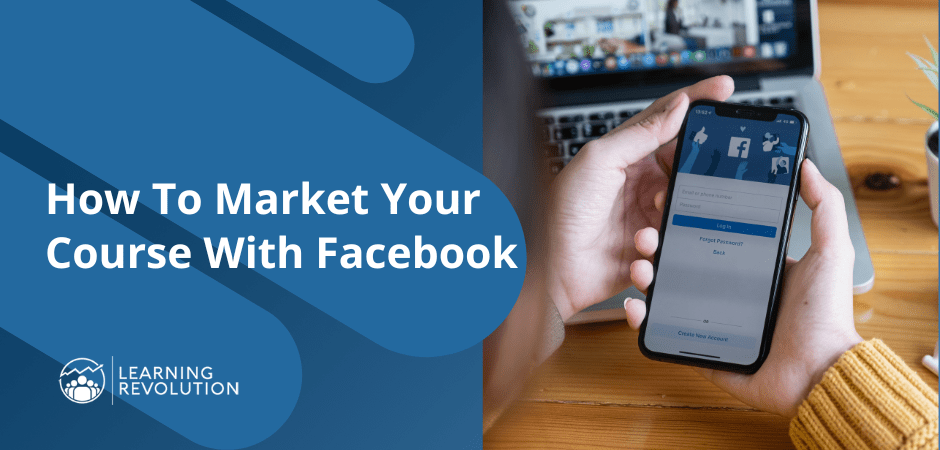

One of the biggest challenges faced by course creators is the ability to generate consistent leads. Even with a sizable audience, creators still need to find ways to expand their reach and grow their online business.
If you’re looking for a platform to market your online course, Facebook is a great place to start. With over 3.03 billion monthly active users, Facebook is the largest consumer database ever created. You can leverage this powerful platform to market and sell more courses to your target audience.
But how do you find your target audience amongst the crowd?
In this in-depth guide, we will look at the different tools Facebook provides to help you stand out from the competition and attract the right learners to your course.
We’ll also look at different strategies (free and paid) that you can use to get your course in front of your target learners, as well as the built-in tools to automate your online marketing strategy.
Without further ado, let’s dive right in.
Why Use Facebook to Market Your Online Course?
Facebook is a goldmine for online course creators thanks to its billions of users with whom you can connect and add to your Facebook page or group.
If your learners are already on your network, you can easily contact them directly on Facebook to let them know about your online course.
You can also share updates on your page to market your course for free.
Facebook also allows you to generate contacts directly via your page. You can do this by adding a sign-up button on the page. This will allow you to gather valuable emails to which you can send promotional messages about your online course as part of your marketing strategy.
You can host a webinar on Facebook, conduct live sessions, and create groups where your clients can connect with you to discuss your course topic.
Facebook also comes with advertising tools designed specifically to help creators reach broader audiences and target potential customers according to their demographics, interests, age, language, and various other factors.
You can also use Facebook Pixel to retarget users who have previously visited your website or blog, and show ads for your online courses specifically to those people.
Here are some of the most prominent benefits of using Facebook to market your online course:
Convert Customers With Effective Facebook Advertising
Facebook Ads allow you to narrow down your ideal audience so you can specify exactly who should see your ad, how often, on what platform, and what times of the day.
It’s a fine-tuning machine that lets you define your budget according to which pricing option works best for you – whether it’s CPC, CPA, CPM, or CPL. This means you only get charged when someone engages with your ad.
As a Facebook user, you also get access to a full suite of tools to optimize, track, and analyze metrics so you can achieve a higher return on your ad investment.
Target Your Ideal Audience for Increased Revenue
With the right Facebook targeting strategy, it’s possible to target your ads with such precision that you achieve an almost immediate increase in your traffic and sales.
This helps to improve your Google ranking, edging your website closer to the top of the search results page.
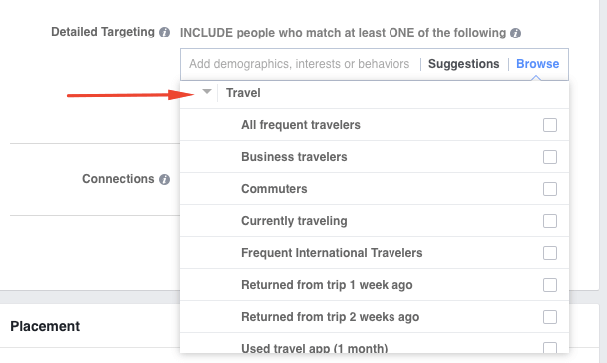

You can use the “Audiences” feature in Facebook ads to import customer emails and addresses to use in your Facebook ad campaign. This helps to drive repeat sales.
Furthermore, as a social platform, happy customers regularly engage with your targeted users which helps to spread the word about your course.
And check out our Ultimate Guide to Audience Research for additional related tips.
Dominate the Competition With Superior Facebook Ads
As an online course creator, you need the right tools to help you succeed in your business, allowing you to do more of what you love. This also includes tools to help you stand out from competitors so you can attract your target audience.
Facebook provides you with tools to scale and grow your business, and with the right digital marketing strategies, you’ll be able to create a high-impact and profitable online course business on Facebook.
The bottom line is that whether you are using free or paid marketing strategies, Facebook offers an extensive pool of prospective customers across the globe.
It’s a powerful course marketing tool that lets you broadcast your message to the masses or laser-focus on specific demographics just as easily.
Now that you know why you should be using Facebook to market your online course, it’s time to discover effective ways for you to sell more courses on the platform.
1. Create a Facebook Business Page
The first step is a no-brainer. Before you can start to market your course on Facebook, you need to have a Facebook business page.
Your page is a basic necessity for marketing your course. Not only does it help you build a solid and professional Facebook presence, but it also makes it easier for potential learners to find you and the products you are offering on the social media platform.
Pro Tip: When creating your business page, make sure to include targeted keywords within the descriptions.
If you don’t already have one, sign up for a Facebook business page and enter your information, making it as detailed as possible to make your page more searchable and provide page visitors with a clear idea of who you are and what your course is about.
Once your Facebook page is created, it’s time to promote it so you can increase your reach. Just make sure to share a few posts on your page first before promoting it to let people know why you’ve created the page and the type of page content they can expect.
Ways to Promote Your Facebook Page
- Like Your Own Page: The first thing to do is to like your own page. This way, your friends on the platform will see it, and they’ll be more likely to follow your Facebook page as well.
- Use Your Network: The next step is to tell your network about your new page. Share the page through your personal profile, as well as in relevant groups, and invite friends, connections, and learners (both previous and current) to follow it.
- Use Your Blog: Add a follow-up button on your blog and create a short blog post to announce your presence on Facebook. You can also add a sign-up button for your newsletters and blog posts. This can be easily done using email service providers.
- Leverage Other Social Media Channels: If you use other social channels like LinkedIn, Instagram, or Pinterest, you can tell your followers there that they can now reach you through Facebook, as well.
- Send an Informative Email: If you have a list of business contacts or previous customers, you can send out an email telling them about your new social media presence and ask them to like your page.
- Share Your Page on Relevant Groups: Join relevant Facebook groups connected with your e-learning niche and share your new page there. Just remember to add value and engage with others in the group before posting the link to your page.
- Associate With Your Page: On Facebook, you can plug any pages that you manage. This information is displayed in your personal profile and is a great way to promote your page to new audiences.
2. Post Consistently on Facebook
Once your Facebook page is created, the next step is to create a plan for posting consistently on the platform. You need to keep your page updated with fresh, engaging content. Aim to create at least two or three Facebook posts per week.
You can share different types of content, including:
- Updates about upcoming courses
- Tips and advice about e-learning
- Curated resources to enhance learning
- Photos and videos from educational events
- Behind-the-scenes look at your business
You must commit to a content strategy so you can attract the right people to your online course.
You should already have a good idea of who your target audience is, what their interests are, and the type of content that resonates best with them. For most course creators, the best approach is a mix of text-based and video content related to their course subject.
You can follow the same strategy for your business to create high-quality content that adds value to your followers’ feeds.
The example below is from Jenna Kutcher, an online course creator who uses Facebook to market her courses.
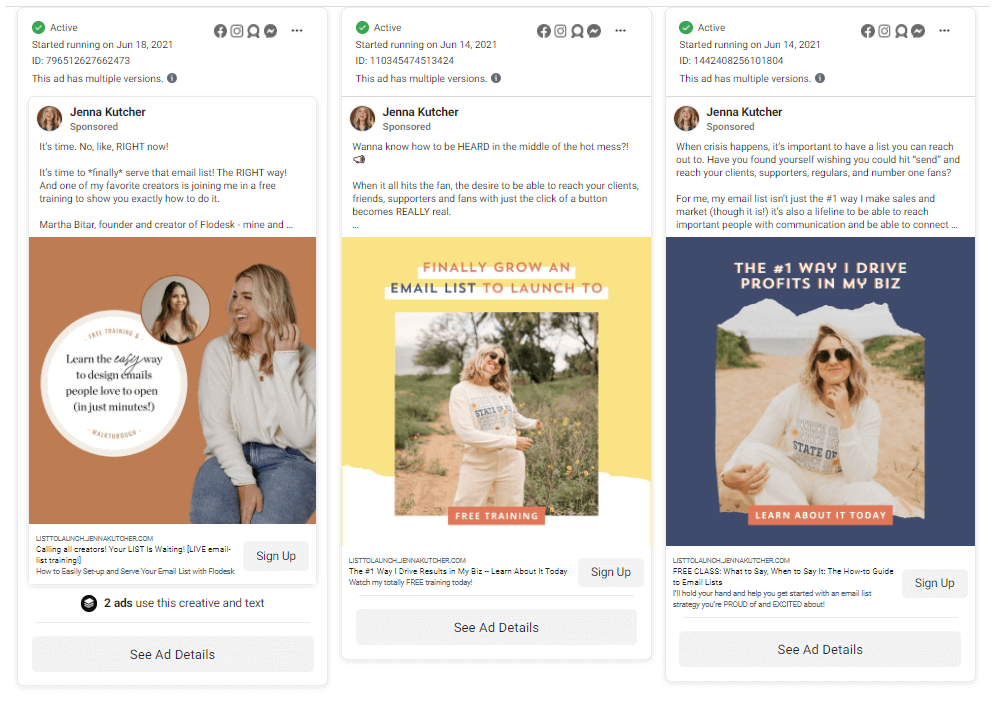

Here are some tips to help you create a winning content strategy:
Use a Content Calendar
One of the best ways to help you create a plan for posting consistently on your business pages is to use a content calendar.
Focus on quality over quantity to ensure that you’re posting valuable content on your Facebook page. If you focus on providing value, the followers and likes will follow.
Interact With Your Audience
As any marketer will tell you, nothing sells in isolation. Even if you build a page and post consistently, you still might not see the results you desire.
That’s because your audience on Facebook is the lifeblood of your business, and you must interact with them frequently to help you sell your online course. The more you interact with your followers, the easier it is for you to establish your credibility and build a solid reputation online.
Engaging with your audience also provides you with the opportunity to turn some of your followers into brand ambassadors.
And, Facebook’s algorithm favors users who create engagement. That’s why it’s essential for you to create content that encourages meaningful conversations among your audience.
Track and Measure Results
If you are new to course creation and are unsure of what your audience likes, you can experiment with different types of content to see what performs best.
You can also run polls to help you understand your audience more. Measure different performance metrics and tweak where necessary to optimize your results.
3. Build a Community With a Facebook Group
With your Facebook business page created, and a plan of action in hand for posting consistently, it’s time to focus on building a community around your topic.
As a course creator, selling your product online is all about getting potential customers to know, like, and trust you. This is known as the KLT factor, and building a vibrant Facebook group helps you get a high KLT factor which leads to increased conversions and sales.
One of the reasons why a group on Facebook works so well is that it isn’t quite the same as building an audience for your content, it’s more like building a tribe of like-minded people with whom you can connect on a deeper level.
The people in your group can ask you questions, learn from fellow members, share their opinions, and give you valuable feedback.
Also, compared to Facebook pages, the reach of Facebook groups is much higher.
Groups make it simpler for you to interact with your audience and give you an easy way to share resources, make announcements, and drive meaningful conversations within your community.
When creating your Facebook group, give it an SEO-optimized name. This makes it more likely to appear in relevant search results. The name should be something that is closely related to your e-learning niche.
Once your group is created, ask your audience to join the group, and create a plan to post useful content as consistently as you do on your Facebook page.
If learners post any queries, make sure to give them instant feedback. If you don’t have the time to do so yourself, you can simply appoint someone else to do this job.
Here are a few other things to keep in mind when building your group:
Moderate Your Facebook Group
Regardless of the field you’re in, there’s always a chance that you might attract a few bad apples. It’s important for you to moderate your group to ensure that poor behavior doesn’t affect other users.
Develop a basic application process that allows you to vet new members and create a set of rules and guidelines that inform users of the group’s expectations. This helps you build a positive group culture where every user can share their opinions freely.
It’s crucial for group members to feel comfortable enough to share their thoughts, ideas, and questions without having to contend with negativity or abuse on the forum.
Post Content That Encourages Engagement
Successful Facebook groups don’t happen by chance. Unlike a Facebook page where it’s mostly about your followers reacting to the content you post, your community is primarily about communication.
You need to have a plan in place for creating content that fosters engagement among your members.
For example, you might use tactics such as announcing giveaways or giving free goodies to your community to enhance your community and boost engagement.
Maybe you could offer your first 100 members a customized T-shirt or coffee mug. These are simple ways to get people talking, asking questions, and sharing your content.
You can also share polls asking questions that encourage members to talk to each other. You can even allow users to post their own questions, which helps to take the pressure off of you having to always initiate.
In fact, this can lead to even more engagement because users will be able to come up with questions and topics for discussion that you might not have thought of.
Master the Art of Soft-Selling
When marketing your online course on Facebook, one of the biggest mistakes you can make is to try too hard to sell it to your group members.
Your Facebook group should be a space for members to connect with like-minded learners, not a platform for you to constantly sell your course to them.
You must practice soft selling, which means you can mention your course from time to time, but the main focus should be on communication and engagement with your members.
Once people get to know the value of what you have to offer, they will seek out your course without you having to do any hard sells.
Get more tips on how to increase online community engagement here.
4. Use Facebook Live
Now that you’ve got people involved in your Facebook group, you can start leveraging other tools on the platform to build and engage your audience.
Facebook Live is one such feature that can help you sell more courses.
Doing “Lives” is a great alternative to conducting webinars and it allows you to provide potential learners with a taste test of what you have to offer, as well as give them a look at the type of teacher you are.
This is important because if they purchase your course, they will be spending a lot of time with you, so they need to be able to know if your teaching style works for them.
Use Facebook Live to introduce yourself, showcase your teaching style, and give potential students the opportunity to interact with you in the moment.
The real-time video streaming nature of this marketing channel makes viewers feel as if they are in a one-to-one session with you.
Going live also leverages the preference of most people to learn via video over text. You can use this format to pique your audience’s curiosity by giving away some of your material (but not too much) to entice them to sign up for your course.
You can announce on your stories, business page, and community page to let your audience know about your upcoming Facebook Live sessions.
During a live session on Facebook, make sure to keep an eye on your audience’s comments and reactions. Respond to comments instantly to keep the conversation going and build lasting relationships with your learners.
Learn more about how to livestream an event.
5. Leverage Facebook Messenger
Facebook Messenger is another effective way to sell more online courses on Facebook. If used correctly, Facebook Messenger offers you the opportunity to reach new customers through direct outreach.
That’s not to say you should approach anyone and everyone, telling them about your new course. The way to use this channel effectively is to be subtle and targeted.
Use it to form a rapport with users who already know who you are and are familiar with the work that you do. No one likes unsolicited messages from strangers. It feels too intrusive. However, if they have engaged with your content before, then chances are they know, like, and trust you, which means that their response will be very different.
To find users who’ve interacted with your brand before, take a look at the content you’ve produced so far – whether it’s your Facebook page updates, Facebook group posts, or Facebook Live sessions.
Make a note of the people who positively reacted to you. These are the ones you want to reach out to on Facebook Messenger.
Of course, even if people know you, you shouldn’t be too “sales-y”. In fact, you shouldn’t even mention your course if it doesn’t feel right. Just do your best to offer value during this private interaction and it’ll likely make them more receptive to your online course when you do mention it later on, elsewhere.
6. Generate Profits with Facebook Ads
Up until now, we’ve discussed all the different ways you can market your course on Facebook for free.
However, if you want to see faster results, it’s a good idea to consider using Facebook ads, as well.
Paid advertising is perhaps the most powerful feature on Facebook. When you’re just starting out, it may be challenging to reach your target audience using organic means. Even if you’ve been at this for a while, you may want to maximize your reach to help you grow your business.
In either case, Facebook ads are your best bet.
Facebook ads look like normal posts. However, they are highly targeted and, unlike posts whose reach continues to diminish, Facebook ads have the potential to reach broad audiences within just a few hours.
One of the best things about using Facebook ads is that there is no minimum budget required. You can start small, even boosting a post for a few dollars can go a long way toward helping you achieve your marketing goals.
Thousands of creators fail to take advantage of this feature-rich system. Many consider it to be a mystery, but with the right strategy, you can use Facebook’s clever bidding system to generate profits for your online course business.
If managed with the right expertise, Facebook ads can be your best tool for acquiring leads, nurturing them, and making more sales.
Here’s how you can use Facebook advertising to market your course:
Option #1: Boost and Promote Your Post
When it comes to promoting online courses on Facebook, running a paid ad is the easiest way to reach your goals.
There are two ways to create Facebook ads based on the level of customization. You can either “boost” your post, or you can use the Facebook Ads Manager.
Both methods have their merits. However, if you are new to Facebook ads, it’s probably best to start with boosting your post.
All you have to do is create a post on your Facebook page and then you can advertise the content directly to your audience by boosting its reach.
The process is simple, and the settings are easy to configure. The ad requires just three basic inputs, including:
- A budget;
- Your target audience; and
- The duration that you want your ad to run.
Boosting your post can help you get more messages, video views, and leads. Just be sure to configure your call to action (CTA) button to align with your marketing objectives, as in the example below.
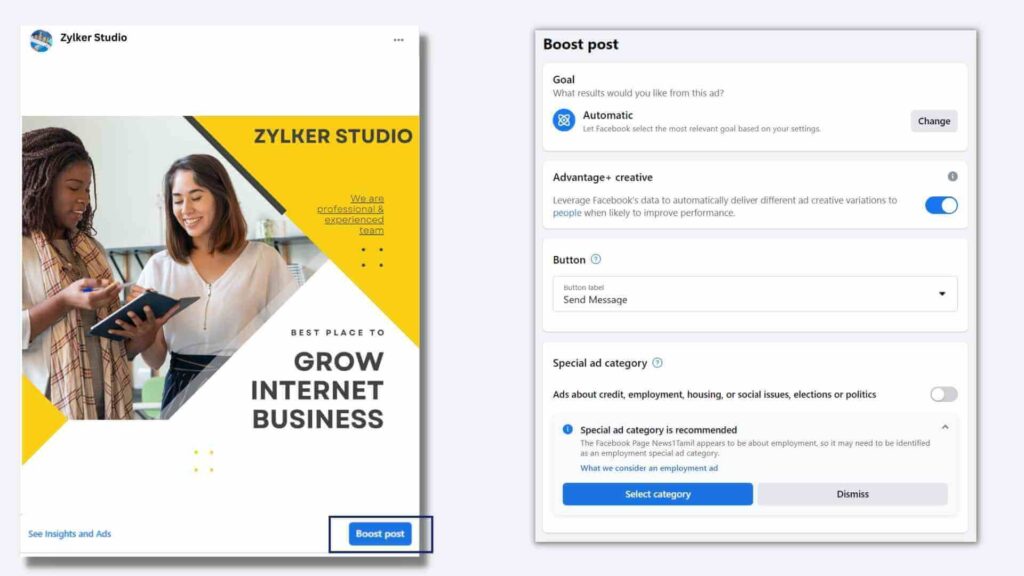

The more compelling your call to action, the more likely it is that people will take the desired action, such as visiting the website or signing up for your newsletter.
Boosting a post on Facebook helps you get more page likes, comments, and shares. It’s great for brand awareness. However, you get limited customization which means that while great for beginners, it’s not ideal for experienced users looking for more ad customization options.
Option #2: Use the Facebook Ads Manager
If you have different goals, you can advertise via Facebook Ads Manager. This feature has powerful tools to run advanced marketing campaigns.
Instead of creating your ads through your Facebook page, you will use the Facebook ads manager for more customization features so you can laser-target your audience.
Facebook’s targeting features allow you to create ads that reach your ideal learners with certain characteristics, such as age, location, interests, etc.
You can use Facebook ads to:
- Promote your page
- Build brand awareness
- Gather valuable contacts and leads
- Promote your online course
If you decide to use ads to achieve your marketing goals, there are three types of Facebook ad campaigns you should run to promote your online course:
- Traffic campaign
- Lead generation campaign
- Purchase campaign
These are the only three types of ads you need to get prospective learners into your sales funnel and convert them into paying customers.
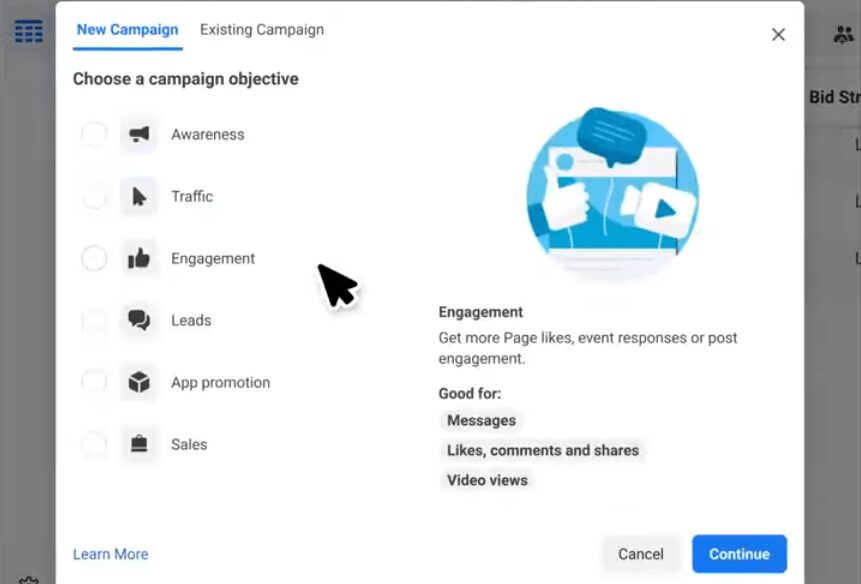

Below, we take a closer look at each one to give you a clear idea of how to use them to sell more courses on Facebook.
Traffic Campaign
The traffic campaign is at the top of your marketing funnel. Use this as a way to target a cold audience so you can drive traffic to your course website.
Video ads offer great results for traffic campaigns. Online course creator, Marie Forleo uses this tactic to generate massive traffic to her course website.
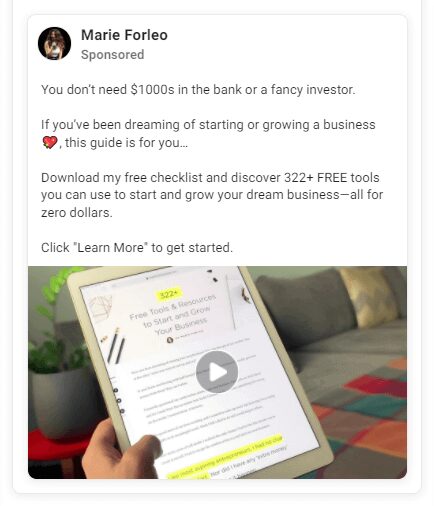

Record a video with a brief introduction of who you are and what your course is about. Direct your viewers to your online course landing page. Make sure your ad copy is compelling from start to finish and ends with a strong call to action for viewers to click through to your site to learn more.
Lead Generation Campaign
After watching your video ad, many people will visit your online course landing page. However, the conversion rate may not be very high at this point.
So, instead of focusing on sales right now, the best thing to do is to offer a lead magnet that visitors will find irresistible.
A lead magnet is a free gift offered in exchange for someone’s contact details. This can be anything, such as a free mini-course, webinar, e-book, report, or checklist.
This allows you to collect their contact information so you can nurture the leads for increased conversions down the line.
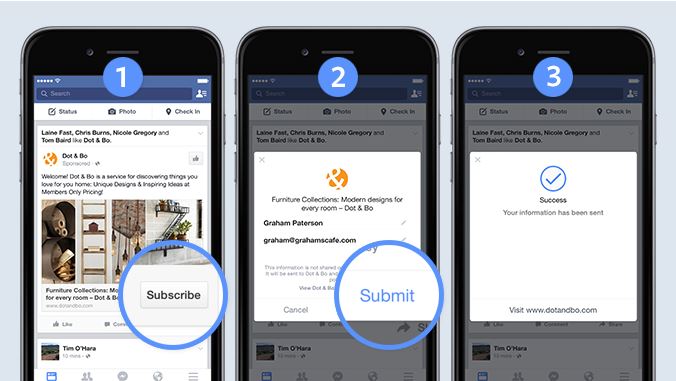

This is the middle of your marketing funnel. You can also use this type of campaign to retarget the audience to whom you showed your traffic campaign ads. To use retargeting ads, simply install Facebook Pixel on specific pages of your online course website.
By now, your potential learners have had two touch points and are aware of your online course. If you have testimonials from previous learners, you can use them to help you build trust with the audience and encourage even more sign-ups.
For example, you might write a marketing script that includes the story of one of your learners and their transformational journey toward achieving their goals.
End with a clear call to action to entice people to sign up for your lead magnet.
Pro Tip: Write longer copy for lead-generation ad content and include an eye-catching image of your product (or previous webinars, mini-course teaser, etc.)
Purchase Campaign
The purchase campaign is at the bottom of your sales funnel. By this time, cold leads have been converted into warm leads or followers.
Now is the time to redirect them yet again to your course landing page – but this time with the aim to get them to purchase your product.
On the page, you can give an offer or use a countdown timer to communicate a sense of urgency. For example, you might tell visitors that your batch will be filled in a few hours and there are only a limited number of seats left.
You can create the same type of copy, visuals, and CTA as the ones in the lead magnet campaigns. Just make sure that your copy communicates the value of your course.
Spell out the benefits learners will get by signing up. You can talk about their pain points, and position your course as the perfect solution to help them achieve their goals.
Be sure to use targeted keywords when explaining your offer so you can increase organic traffic to your landing page.
8 Tips to Optimize Your Facebook Ads for Higher ROI
As you can see, there is a lot to consider when using Facebook ads.
It may take a while for you to figure out everything – from copywriting to video/image creation to selecting the right population demographics, and more.
The good news is that Facebook makes it easy for anyone to get started by boosting your posts. As your campaigns start to yield results, you can increase your budget for ads to reach even broader audiences.
Here are some tips to help you maximize your Facebook Ads ROI:
1. Start Small
If it’s your first time using Facebook ads, the best thing to do is to start off small. Treat your first campaigns as an experiment to hone your advertising skills and give you a better idea of what works and what doesn’t.
After all, it’s not just about getting your online course in front of as many people as possible, it’s about getting it in front of the right people.
It’s a good idea to set a small daily budget and try out a few different targeting options for your marketing campaign.
This way, you’ll learn who your audience is, and once you do, you will be able to double down on the right audience which will lead to more sales for your online course.
2. Create Stunning Visuals
Like most other social media platforms, Facebook is all about eye-catching visuals when it comes to marketing your products.
As a DIY Facebook advertiser, you must take the time to create high-quality visuals. Poorly done graphics and images will only serve to make you look unprofessional. That’s not the way to build trust with your Facebook audience.
Instead, you can either use online tools like Canva, which come with pre-made templates for different types of media, or you can outsource the creation of high-quality visuals for your Facebook ads to professionals on sites like Fiverr who will create attractive images to get you the clicks you need. You can also harness the power of AI to create stunning visuals. Check out our roundup of the top AI image generator apps.
As with all your marketing efforts, test different types of formats to find out which visuals hit the mark with your particular audience. For example, you may find that many of your users respond to infographics, in which case you can use more of those in your marketing collateral to get more engagement.
3. Craft Attention-Grabbing Copy
Most people simply scan through Facebook without reading a lot of the text. Keep this in mind when writing your copy.
Make sure it’s easy to read and scannable. The benefits should stand out, bold headings should capture the attention of anyone scrolling through their feed and stop them in their tracks.
Writing attention-grabbing copy is a skill that many find hard to master. However, there are a few simple tactics you can use to make your ad copy more effective for selling your course on Facebook:
- Lead with benefits for users, not features
- Include a compelling call to action
- Use emotive language to elicit the desired action
- Identify your learners’ pain points and offer your course as the solution
4. Budget and Target Your Facebook Ads Effectively
Your budget and targeting options have a huge impact on the result of your Facebook ad. You need to be able to set the right amount to ensure that you maximize the ROI from your ad spend. It’s possible to get the desired result from your Facebook ad with a minimal budget.
There are two types of budgets you can set:
- Daily Budget: This is how much you want to spend on your Facebook ad each day for the duration of your ad.
- Lifetime or Total Budget: This is how much money you want to spend in total for the entire campaign.
The good news is that when running ads on Facebook, you are only charged for measurable actions that your ads receive from users, such as impressions and clicks. This makes it a lot easier for you to manage your ad spend and calculate the return on your investment.
5. Minimize Factors That Negatively Impact Your Ads
Many factors can affect the performance and cost of your Facebook ads, including your business goals, target audience, and demographics. Your bid strategy also plays a pivotal role in your ad success.
While there is no predefined path or pre-made template that can make your ad perform well on Facebook, there are certain things you can do to increase the chances of success when running your Facebook ad campaign.
Here are the factors to focus on:
- Target Audience: The cost of Facebook ads changes according to the trends in any given location. This means that if more marketers target ads in a particular demographic location, the cost of advertising will be higher in that region because of the increase in competition. That’s why it’s important to analyze your target audience and their demographics (as well as your competitors) before you create your ad on Facebook.
- Bid: Another factor that affects the cost of your Facebook ad is the bid. The price you set determines your ad’s reach. The higher the bid for advertising space, the higher the possibility of you reaching your Facebook marketing goals.
- Ad Placement: On Facebook, you can choose different ad spaces on which to display your ads. If you are new to advertising on the platform, it’s a good idea to experiment with various options so you can find the right ad format and placement strategy that works best for you.
With a continuous process of trial and error, you will be able to find the right strategy that’s best for your online course marketing.
6. Focus on the Right Facebook Ads Metrics
Yet another way to increase the performance of your ads on Facebook is to use campaign metrics that are aligned with your business goals.
For instance, if you are a course creator focused on building a strong community around your product, then you need to look at metrics such as page engagement and post engagement which will give you a clearer picture of how well your ad is performing.
With this information in hand, you’ll be able to optimize your marketing campaign based on your ad’s performance metrics.
Depending on your goals, you can also apply past ad campaign strategies that performed well to help you get better results in future campaigns.
Once your campaign is running, avoid editing any part of it as this will affect the platform’s ability to serve your ad to the right audience.
7. Avoid Common Mistakes
One of the most common mistakes people make when advertising on Facebook is to target a cold audience. It’s very hard to nurture a cold audience. Running a purchase campaign on a cold audience is simply a waste of money.
Think about it, would you buy an online course from a total stranger? Chances are you wouldn’t, right?
Your audience is no different. They will not buy your course if they do not trust you. Your prospects have to go through the first stage of your sales funnel first to get warmed up before you ask them to buy your course.
That’s why you should first run a traffic campaign and use retargeting ads to build trust.
Make sure to include lots of testimonials and social proof in your marketing materials. These serve as a motivating force and create a “bandwagon effect”. This means that people will be more likely to engage with your content if they see that other people are doing it.
Another common mistake is to start advertising on Facebook without having a well-thought-out strategy to follow.
Before you can run successful ads, you must know the objective behind the campaign. Define your end goals and understand the purpose behind your specific campaign. For example, is your goal to gather attention and increase brand awareness, or is it to sell more courses?
8. Link Free and Paid Strategies Together
You may see some success using a free Facebook marketing strategy. Likewise, you’ll experience good results by using Facebook ads to market your online course.
However, combining the different aspects of free and paid strategies will help you maximize the results of your efforts.
Here are some examples of different ways you might implement this in your marketing strategy:
- Simultaneously manage a Facebook group and a Facebook page to cover more ground
- Run Facebook ads for your Facebook Live session or group
- Use retargeting to offer a related product, service, or content
- Message Live session attendees afterward to offer additional resources
You’ll be able to get better results faster by mixing different strategies rather than using them as standalone tools in your Facebook marketing arsenal.
Bonus Tip: Consider Hiring a Facebook Marketing Team
As this guide has shown, you can run your own Facebook ads successfully. However, there’s a lot to get through, and if you have neither the time nor the bandwidth to dedicate to such a project, the next best option is to hire a team.
There are many Facebook marketing services available, including platforms like ClassGrowth.co and ThinkOrion.com. They have a revenue-first approach designed to help you build a strong brand, accelerate growth, and maximize revenue per user.
All you have to do is inform them of your goals and your ideal customer segments and they will take care of the rest.
They’ll plan, execute, and create a hands-free marketing campaign which they then manage from start to finish.
You’ll get all the services you need in one place and experts to manage every single aspect of marketing online course on Facebook, including the following:
- Landing Page Creation: Veteran copywriters will create custom-tailored landing pages that use current best practices to speak to your target demographic and encourage sales.
- Organic Course Marketing: There’s no need to go through the hit-and-miss process of trying to discover which organic marketing processes work. Facebook marketing agencies have proven systems in place to help you get results fast.
- Facebook Ads Marketing: Media buying can be an involved and time-consuming process. When you hire expert media buyers, they take care of all your paid traffic accounts.
- Copywriting and Content Creation: Expect copywriters have what it takes to create compelling copy that will transform words on your landing pages, website, and social media into sales.
- Web and Graphic Design: Experienced professionals will plan and design high-quality graphics, website layouts, and even your brand image for a professional result.
- User Experience: You can offer an enhanced user experience thanks to expertly crafted digital marketing strategies that leverage your knowledge and remove barriers for your learners.
- Email Marketing: Combining Facebook marketing tactics with email marketing is a great way to increase your impact and generate more sales from the audience.
When you have a team taking care of all these things and more, it not only shortens your sales cycles, helping you drive exceptional sales results for your course, but it also frees you up to focus on providing high-quality content to your learners.
How to Market Your Course with Facebook – The Final Word
This step-by-step guide has made it clear how powerful a tool Facebook can be to help you sell more courses online.
Whether you’re using organic ways or paid ads to promote your online course on the platform, you stand to benefit by focusing on this platform as a way to market your course.
Use the built-in features like business pages, groups, Facebook Live, Messenger, and Ads Manager to improve your course marketing so you can enlist more paying learners.
If you’re ready to maximize your online course’s potential, Facebook is an excellent tool to market and sell your online course or other educational offering.
FAQ
What are some free ways to promote my course on Facebook?
You can promote your online course on Facebook for free by uploading and posting content related to the course on your page and in related groups. Add a link to your landing page to drive traffic to your course website. You can also use Facebook Live to engage with interested users, as well as run contests and giveaways to boost awareness and get more people interested in your product.
What are the marketing features of Facebook?
Facebook has features designed for marketers, advertisers, sponsors, and other business people. Options include tools to help you build an effective advertising strategy, build brand awareness, and target the right audience for your products. Facebook also has a Business Resource Hub where you can explore tips and training on how to leverage all the different marketing tools on the platform.
How do I promote my course on social media?
There are plenty of ways to sell online courses on social media platforms like Facebook, Instagram, and LinkedIn. Some of the most commonly used strategies include using polls to build engagement, posting links to a landing page on your profile and in groups, as well as reaching out on Facebook Messenger to build one-to-one relationships with your audience.
Do Facebook ads work well for online courses?
Facebook ads are among the best ways to promote your online course. Facebook has over 3 billion monthly active users, which makes it the perfect marketing channel. No matter which niche you are in, you’ll find your customers on Facebook. Facebook ads work particularly well because they allow you to laser-target your ideal learners to get your course in front of the right audience.
How do I create a Facebook ad?
To create a Facebook ad, you must have a Facebook account and a Facebook business page. Once these are set up, you can use the Facebook Ads Manager to edit all your ad settings, such as budget and targeting, from one place. You’ll also be able to see all your performance metrics in one consolidated view, making it easy for you to analyze the results and make informed changes to your Facebook ad campaigns.
How much does advertising on Facebook cost?
The cost of running ads on Facebook differs depending on your targeting options and budget. So, for example, you might pay per click, download, like, or 1000 impressions. The average cost per click is around $1.72, whereas the average cost per 1000 impressions is around $11.20. You can create your first campaign for just a few dollars, and set a daily or lifetime budget for your ad.
How can I target my Facebook ads to specific audiences?
On Facebook, you get a wide range of targeting options that allow you to reach the right audience for your online course. You have the option to target your audience by location, gender, age, behaviors, interests, and more. There’s also a retargeting feature called Custom Audiences which lets you target people who previously interacted with your business, e.g. by using your app, watching a video ad, or visiting your website.
Table of Contents

